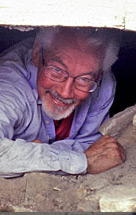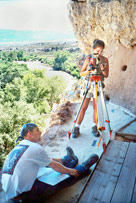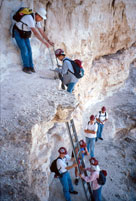Prospects for preserving buildings and cultural sites of historic
significance throughout the state and elsewhere were boosted
Friday (Dec. 2) with the establishment of the Center for Heritage
Conservation in the College of Architecture at Texas A&M
University.
The center will conduct research, teaching and service projects
related to management and preservation of historic buildings, places
and cultural sites, noted David G. Woodcock, who will serve as
its director.
The new center will unite faculty from academic departments across
the university and will build on the work of the 14-year-old Historic
Resources Imaging Laboratory, which it will replace. It will take
over administration of the graduate certificate in historic preservation,
which has already been awarded to more than 150 students from 11
disciplines in six colleges, explained Woodcock, a professor of
architecture who has specialized in historic preservation work
since 1964.
"Since 1991, Professor David Woodcock and his associates at
the Historic Resources Imaging Laboratory have earned national
acclaim
for their impressive body of work in historic preservation while
instilling in generations of students a passion for conserving
our rich architectural legacy," said J. Thomas Regan, dean
of the College of Architecture. "The establishment of the
Heritage Conservation Center at the College of Architecture promises
to expand Texas A&M's significant influence on historic preservation
and resource management and further assure the integrity of our
treasured architectural heritage in Texas and throughout the world."
The center was established by The Texas A&M System Board of
Regents. In addition to its certificate program, the center will
continue field research begun in 1977, which has added more than
60 historic Texas buildings to the Historic American Buildings
Collection in the Library of Congress; support faculty research
projects focused on numerous locations around the world, including
the D-Day landing site at Pointe du Hoc, Normandy, France and the
petroglyphs at Montezuma Castle National Historic Site in Arizona;
facilitate the placement of graduate students for internships and
other work experiences; and continue and expand upon the tradition
of annual symposia that have brought national and international
speakers to the Texas A&M campus.
"Texas A&M University is rooted in tradition and heritage, and
I am delighted that the Board of Regents has approved the establishment
of the Center for Heritage Conservation," Woodcock said. "It
will provide an effective focus for the ongoing teaching, research
and service activities of faculty from across the campus who share
a dedication to the wise use of our built and natural resources,
and to the understanding and nurturing of our rich cultural heritage,
and it will grow the quality and the visibility of our work."
Funding for the Center for Heritage Conservation will be provided
by the College of Architecture and through grants and gifts for
specific projects from sources such as the U.S. National Park Service,
the National Center for Preservation Technology and Training, the
American Battle Monuments Commission and individuals and professional
architecture firms.
The Board of Regents met Thursday and Friday (Dec. 1-2) at Tarleton
State University in Stephenville.
| |

David Woodcock, director of the Center for
Heritage Conservation

Montezuma Castle National Historic Site, Arizona

Students at the Montezuma Castle site

Aggies make the climb at Montezuma Castle
Larger images>>
|




